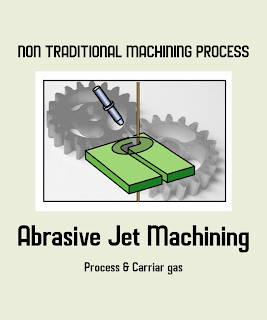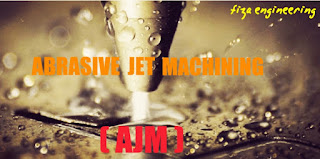NON- TRADITIONAL MACHINING PROCESSES
ABRASIVE JET MACHINING (AJM).
It is the removal of material from a workpiece by a high speed system of abrasive particles carried by gas from a nozzel. The process is used chiefly cut materials that are sensitive to heat damage and thin section of hard material that chip easily and to cut intricate holes that would be more difficult to produce by other methods
PROCESS :
Abrasive powder is fed from a mixing chamber that vibrates at 50 Hz into an orifice chamber where it is entrained in the gas stream and then paged through a connecting hose finally emerging from a small nozel at high velocity. Power feed rate is controlled by amplitude of the mixing vibration and pressure regulator controls the gas flow.Duplex units allow uninterrupted production while reloading or can perform independent operations with different abrasives. The pressure can be released through blow off outlets in some units. Abrasive flow from the nozzle can be stopped in 10 to 15 milliseconds.
The nozzle is mounted in a fixture for automatic operation either the workpiece or the nozzle being moved by cam drives, pantographs or other suitable mechanisms. Nozzles most be highly resistance to abrasion and are made of tungsten carbide or synthetic sapphire. For precision cutting nozzles are made with an external taper on the tip to minimize Secondary ricochet of abrasive particles that robound from the workpiece.
Abrasive materials used in abrasive jet machining include aluminium oxide, silicon carbide, dolomite (calcium magnesium carbonate), sodium bicarbonate and small glass heads, hardness, strength, particle size and particle shape of the abrasive affect its cutting performance and life.
Abrasives are not ordinarily re-used because of reduced cutting action they give and because contamination with material abraded from the work can clog small orifices in the equipment and the nozzle.
CARRRIER GAS :
Ordinarily air, naytrogen or carbon dioxide is used by us the carrier or propellant gas. Commetrical cylinder gases are usually of satisfactory purity.
Nozale pressure can range between 2 and 8.5 bar but ordinarily is about 5 bar. High pressure results in rapid nozel wear, low pressure gives slow removal rates.
ADVANTAGE :
(i) Ability to cut intricate hole in matcrial of any hardness.
(ii) Ability to cut fragile, brittle or heat sensitive material without damage,
(iii) Absence of mechanical contact between tool and work.
(iv) Low capital cost.
DISADVANTAGE :
(i) Limited applicability because only small amounts of metals can be removed and nozzle must be close to the workpiece.
(ii) Slow removal rate and inefficient use of power.
(iii) Embedding of abrasive in the workpiece.
(iv) Stray cutting.
APPLICATION :
Abrading and freestone glass, cleaning cutting, fine lines exposing an area for electrical contact machining semiconductor
Such as germanium,sillium, cutting and etching materials such as quartz, sapphire,mica and glass, deburring, marketing.
Writer - sk najmul ( munna )




0 comments:
Post a Comment
Please do not enter any spam link in the comment box.